Don't wanna be here? Send us removal request.
Text
I loved the ten rules. I thought that they were so inspiring. I especially liked rule number 6 and 9. I thought that the article for an artists life was a little weird but interesting at the same time. Some of the things that they talked about shocked me because I wasn’t expecting that. I thought it was interesting that it said an artist should suffer because their greatest work will come from suffering. I also thought that the rule about the nine things that artists should own were a little weird. If I had to choose nine things to own I wouldn’t have chose most of that stuff.
Week 16, last post.
These ten rules are meaningful. It’s a great way to end this with this reading. I could use this as a reference to distress. Rule four is something to always consider, everything is an experiment and we all take different tries, and different outcomes from it. No one knows what the results will be and they are never the same for everyone. Rule six ties in with rule four, if we take everything as an experiment than nothing should be considered as a mistake. Which makes no one perfect at anything. Rule nine is perfect, that is the one I liked. I liked it because it’s true, we need to be happy whenever possible and enjoy ourselves.
In Marian Abramovic’s article, it was an interesting reading. It almost made it seem like if I was reading the 10 commandments out of a bible except this would be like a bible for artists. I really enjoyed reading this article because it was something different and even the layout for it, it almost made it seem like it would be a song lyric because of the repeat of some of the lines. There were like lessons that everyone should follow and not just for artists, because everyone has the ability to become an artist.
This class really help me learn to take a different view on art. For a future reference, this course could help me because it was learning to view different pieces of art in a different way. I had always enjoyed learning about art, the different kinds of media and what can and could not be art, but honestly anything we see every day can be considered art. I knew the basic idea of art being paintings, drawings, sculptures, photography, and even digital and visual art, but posting each week about each one and finding relative artists helped out a lot on gaining more knowledge about these topics.
These two pictures I have honestly fallen in love with. The first one is called Rising by Clair Morgan, and I love this picture because it shows what looks like a rose or a ball of something just rising. The title fits well with the piece of work. The second picture is what I wish to go to someday. It is the infinity room by Yayoi Kusama. Honestly I have this picture as my background on my laptop because it is so abstract and filled with color, it is just amazing. It makes me think of looking up at the sky at night and seeing the millions of stars up there.


1 note
·
View note
Text
Week 16
I found the article “An Artist’s Life Manifesto” very interesting. It gave advice on what to do and what not to do as an artist. Some of the things that were mentioned in there, I was surprised at. For instance, at the very end, it said that every artist should have their funeral arrangements made before death because that is there final piece of artwork. It was weird but in a way I found it unique because it would be the last thing that the artist has put together. Something else that I found interesting in there was that they said that an artist should suffer. An artists best work comes from suffering. Supposedly, when an artist suffers, they connect with their inner spirit. Something that I was shocked at was that it said that an artist should never be depressed. I found that interesting because when they say that an artist should suffer, I relate that to depression. Apparently they are two different things if you should suffer but not have depression. The part that talked about Buddhist Monks telling an artist the best nine things that they should own was different. Some of the things that they mentioned were not what I would have in mind if I had to own nine certain things.

I thought that the article of “10 rules for students and teacher” was an awesome read. There was some great advice in the 10 rules. I especially liked rule number six and nine. Number six said “Nothing is a mistake. There’s no win and no fail, there’s only make.” Number nine said “Be happy whenever you can manage it. Enjoy yourself. It’s lighter than you think. Which is so true. Even though life may takes us down paths that we don’t like, make the best out of it. Life is too short to be sad. Live your life to the fullest.

Before this class, art was involved in my life, but not very much. I really didn’t get into art that much. Before I started this class, I thought that I needed to take art classes in able to be apart of the art world. I realized I was wrong though. Art happens in our lives everyday. The way we dress and the way we decorate our house is a type of art.
I also learned that there is much more to art than I thought there was. Art is more than just paintings, sculptures, and drawings. There is sound. Which really socked me and I am still having a hard time accepting that it is considered art. But that just showed me how wide the variety of art there really is. I am glad that I took this course. This course really did change my perspective on what art is. I am not sure how much it will impact my future engagement in art. For instance, I don’t know if I see myself going to another art gallery in the near future.
0 notes
Text
There are so many different parts to digital media its crazy. I thought it was cool when the book said that she computer has built in math equations so that it has perfect lines. It said that people use to have to insert these equations themselves but once technology upgraded the computers were built with them. I also thought that the video by Tabaimo was weird. The kitchen video and the bathroom video were odd and I didn’t quite understand them so I did not really care for them. I also thought that the video by Yung Jake was odd. It was too busy for me.
Week 15
Chapter 9 is based on digital art. With digital art it can include: internet art, digital drawing, videos, projections, installation, virtual reality, and video games. This is just some things that are considered digital art but the list goes on. Digital art is mostly seen on a computer screen or a cellular device. Not only is it seen on a screen but it’s mostly created from a computer. For instance, the chapter has a section on having a drawing medium for the computer. With the example shown for the computer drawing, it looks like it is pixel. If you look at this example far way it looks like little dots made up with different shades of black. Once you look closer you can tell that the dots are a little stars. Also in the reading it talks about the painting medium on the computer. I feel like this looks more realistic and it’s really pretty, especially with the mountains. With digital art, I feel like you can either make it realistic or you can make a really good cartoon.
I found this week’s video a little odd. One thing that I found odd was the video Tabaimo made. I understand she was trying to represent the kitchen life and the girls life as a Japanese but it was so odd to see. The one part that I found weird is when the chief is cutting vegetables and then moves on to cutting a person and removing their head over and over again. I don’t really know what she was trying to represent in this video by that part. I really enjoyed the video because at the beginning it shows the doors closed and then they open to the cook. At the end, the doors are open and the camera zooms out and the doors closed. I found this very important to the video and it gave it something unique, something like a play would do.
I feel like this week the reading and the video came together very well. The artist Tabaimo obviously produced digital art. She produced a lot of videos and it showed with this week videos. I feel like Tabaimo’s work deals a lot with the Japanese culture. The first image is showing one of Tabaimo’s digital art. This is a three screen showing a video. In this video, it’s showing Japanese hands with butterflies/moths in them. To me, it looks like they are letting them go free and flying away.

The artist that I wanted to look more into is Yung Jake. His art is a little odd but really interesting to look it. The second image is a picture of Justin Bieber. This is one of the many art pieces of Yung Jake. I would consider Yung Jake as a digital artist hands down. As you can see in this photo, when you look far away you see little blobs are different colors to try and represent different values of color. Now, zoom in on the picture. You can see little emojis used with the iPhones. This is just incredible to see and it makes me wonder how he ever thought of this. Comparing Yung Jake and Tabaimo is a little hard. Yes, they both represent digital art but they represent different branches of it. I feel like they both care about their art and they both have great potential for it.

1 note
·
View note
Text
I also never considered sound as apart of art either. I am still hesitant to put it under the category of art. I thought it was interesting to find out that they consider listening an act of art. Even though sound art was created in the 1990′s, this was still my first time hearing about it.
Tim Hawkinson was interesting. The blown up sculpture of his face with a motor running it was neat yet odd at the same time. He is a very unique artist. I thought it was cool that he made the raindrop sound like it was a drum.
For the relevant artist this week, I chose Haroon Mirza as well. He reminded me of Time Hawkinson. They both work with sculptures and sound. He also incorporates then together as well.
Week 14 - Sound
Your reflections on the reading
This week’s reading was interesting and contained, again, a lot of information that I never knew or thought of. I never thought to think of sound being considered art so this week is really challenging my view of what art can be. I am still not sure if I really consider sound to be ‘art,’ but I think I can understand why others do consider it an art. I liked that the article mentioned that we are constantly hearing sounds but most of the time we do not listen, or consciously notice it. I also liked that it was pointed out that we usually focus more on the objects that make sound rather than the sound itself. I was also surprised by John Cage’s piece 4’33, which incorporated the audience into the performance by focusing on all the sounds present.
Your reflection on the videos/media
I thought the video for this week about Tim Hawkinson was neat. I thought it was interesting how he incorporates sculptures into his work. His larger scale piece, Uberorgan, was amazing because it was so huge and made equally ‘large’ sounds. The sounds reminded me of whales. I will say though that I really didn’t enjoy any of the sounds made. The “rain drops” were amazing because of how he created them but the continuous sound was just plain irritating for me. Same with Uberorgan, amazingly crafted and unique, but I can only listen to so much of that sound before I just can’t stand it any longer.
Also, I’m one of those types of people that are just incredibly irritated and angered by certain noises so it might mostly just be me that is affected by them in this way. I can hardly stand the sound of chewing, even when someone’s being as quiet as possible, and sometimes have to even leave the room because it makes me so irritated. Same with other small noises, especially if it is quiet and it’s the most prominent noise I can hear. I share a room with my sister and she usually wakes up much before me to do her makeup. I become so incredibly frustrated and angry just by the small short noises of her picking up and setting down her various make up brushes and tools. Even I’m surprised by how angry I get but I can’t help it, even if I know it’s irrational. I usually either put on white noise and fall back asleep or listen to actual music to wake up. So it’s interesting that a lot of noises we simply hear and don’t acknowledge, and there’s others that we can’t NOT acknowledge.

Connections/comparisons you find between the two
There’s the obvious connection of sound being the main point of both the article and the video. They both show examples of how sound can be used in art. One difference I noticed is that Hawkinson uses sculptures to make sound or go along with sounds while the article focused on ways that were strictly sound, like in John Cage’s 4’33.
Connections to another artist’s work
For my relevant artist this week, I chose Haroon Mirza. He does sculptures, installations, and performances. I thought one of his works, the National Apavillion of Then and Now was amazing. It’s a circle of light that gets bright as the noise increases and goes completely dark when the noise stops. I think it’s awesome how that works and it gives me a better understanding of how sound can be art.

8 notes
·
View notes
Text
Week 14
I was sort of shocked when I saw the topic for this week. For week fourteen, we read an article online about sound. At first I thought, how is sound connected to art? But apparently it is. There is actually something called ‘sound art.’ Sound art was created in the 1990′s. Actually, it was created decades before that but people didn’t start labeling it until the 1990′s. The way that sound and art is connected is through listening. Yes, there is a difference between listening and hearing. The article that we were suppose to read states that we are usually more concerned with the thing that creates the sound and not the actual sound. Something I found interesting in the article was that listening is a form of art. Sound artist are very interesting. There was a short story in the article about Hugo Ball who is a sound artist. He was in a costume made out of cardboard, when he was carried onto the stage, he began to make this noise, that was very long and odd in writing. It says that after that, the crowd went crazy.
Tim Hawkinson is a very interesting artist. He does a little bit of sculpture and sound art. The very first thing that we saw in his video was a blown up sculpture of his face that was electronic. It was interesting but weird at the same time. It is cool how it made all sorts of different faces by an electronic motor. How he incorporates sound into his art is through water. He made this drum sculpture, and whenever this raindrop drops on it, it has a beat. He said that he wanted a beat that people could dance to. I thought that Tim’s artwork was unique but a little odd at the same time. I have never seen anything like it. I believe that Tim had a passion for art, but it was more under the category of sculpture and sound so he decided to combine them together.

This is an image of Tim’s face operated by a motor that he made.
For the relevant artist this week, I chose Haroon Mirza. Haroon was born and raised in London. He is still there today living and working. He is known for creating sculptures that include audio in them. Haroon likes to use different types of objects to make sound. I watched a interview video with him and in the beginning it he showed us that he took old records and taped pieces of paper on them in certain spots and then played the record. His goal of that was to make basic sounds. He also likes to involve technology with his sounds. For instance, in the video that I watched he had three TVs hooked up with the same video on it. Haroon reminds me of Tim Hawkinson. They are both into sculpture and sound. Also, they both used technology in their projects. Maybe Haroon enjoys making different sounds but using art by doing it.

0 notes
Text
Week 13
Social practice was the topic for this week. This art medium was confusing for me. I still don’t fully understand it. From the first article that we needed to read, the instructor said that before teaching, he wanted to post on Facebook and see what his friends definitions of social practice were. One that I read that was short and simple yet still gave me a good idea of what it was is “just do normal stuff and then call it art.” I’m not really sure how doing normal stuff can be considered art but I guess it is a very wide category. Nicholas Bourriaud believes that the relationship between the viewers and the art work is the true meaning of art.
Our video for this week was over Tania Bruguera. In the first few minutes in her video, it showed her dancing in a group on the street. I assume that is how Tania expresses her art. She says that as a political artist, she wants her art to have consequences. I think that a lot of her art is based off of being an immigrant. She said that when you become an immigrant, your rights of talking about politics is taken away. I thought that was sad. But she said if you ask anyone where they would want to live, they would say the United States of America. I thought something that she did that i found was very cool was when she had police on horses in a museum telling people where to move to. She wanted people to know what it felt like being told where to go as an immigrant. She takes political talk and being an immigrant very seriously. She has a very strong feeling about how immigrants are treated. I found Tania very interesting. Her art does not involve drawing, painting, or sculpting. She is a social and political artist who expresses her experience as being an immigrant and shows other people that feeling that they have to feel through her art.
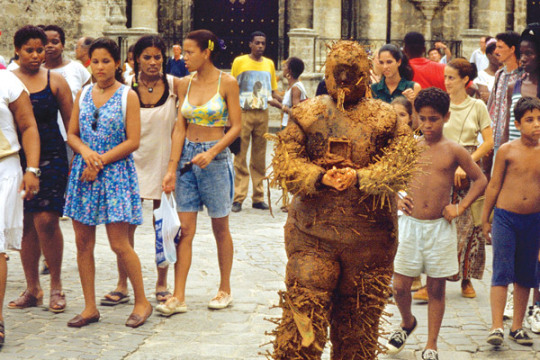
For the relevant artist this week, I chose Theaster Gates. Theaster is an American social artist. He was born in Chicago, Illinois. He still lives there and performs his art. Theaster went to school at Iowa state University. I found that really cool because a lot of people in my school choose Iowa State for their next education after high school. Theaster bases a lot of his art off of racism and poverty that takes place in America. I was reading an article that said he chose to base his artwork off of those subjects because of what he saw growing up in the South side of Chicago. I thought that made sense and before I even read that I had an idea that he based his art off of what he saw as a child. I think that it is sad that people are still dealing with racism and poverty and I think that it is wonderful that people like Theaster are out there trying to help the situation.

Here is a picture of Theaster Gates.
0 notes
Text
Before we read about performance art, I never really knew that it existed. I guess it’s just not something that you hear of very often. I agree that performance art is showing art through your body. Janine was very interesting. She definitely has a unique way of expressing her art. I think that she fits perfectly under the category of performance art because she uses her body for almost all of her artworks. I also thought that the mold of the body on it’s hands and knees with raw hide over it was very strange.
Week 12 Performance Art
This week’s reading was about performance art, and it made me a little confused I must admit. First, I really would have never connected a performance art or “performing” as a type of art, but I surely can see why. I even looked up the definition of performance art on google, which stated it is an art form that combines visual art with a dramatic performance. I read the article about Bree Newsome removing the confederate flag, and I’m still not sure how it would be considered a visual art, but definitely see how it would be a dramatic performance. I think this kind of brings back the idea that people have different versions and ideas about an art, and Bree and her followers considered her removing the confederate flag visual art, but I am having trouble seeing it as something other than a political act or stunt, as some people called it.
This weeks video about a woman named Janine Antoni, kind of confused me also but at the same time interested me. Janine literally uses her body in her pieces. She was shown walking a tight rope, that she weaved out of pieces of clothing given to her by her friends and family. In another piece, it shows her using her hair to paint a floor in a room. I’m not gonna lie, that disturbed me in a way. I personally could never imagine using my body and hair to literally create art. Although she confused me, I saw she was extremely passionate about her art and pieces, which was inspiring. After watching Janine, I could for sure see how performance art should be considered an art category.
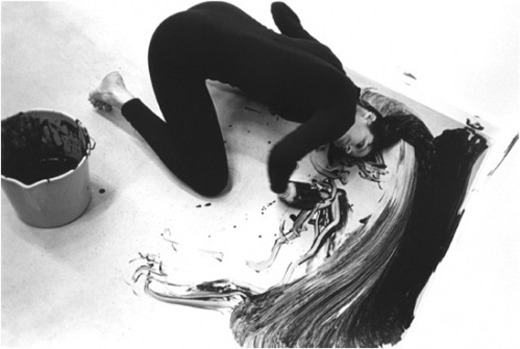
This week I chose to research Adrian Piper. Adrian was born in Manhattan to a middle class black family, and her work consisted of focusing on the issues of racism, ostracism, and otherness. In 1973, she describes the time when she decided to put a mustache on her face, put on an afro wig, and wear a pair of huge wire-rimmed circular shades, and walked down the street dressed as a man.

Adrian makes it her life’s work to install that life isn’t just about racism issues, it’s also about a sense of self, gender, and nationality. It is her goal as she runs her foundation in Berlin.
This week I learned a little bit of a different side of art, and if I am honest I wasn’t sure if I liked it. Some of it I found confusing, some of it I was disturbed by the work, but some of it looked inspiring, and I could see how it would be inspiring to others. I just keep getting amazed by all the different types of art I learn about, that I would never have thought about before!
1 note
·
View note
Text
Week 12
Performance is considered one of the many types of art forms. Performance is about using your body to speak to the audience instead of painting a picture and showing it off in a gallery. It is about doing an act and having the audience give you feed back. Performance art is very interesting. When we think of art, we tend to think of things like painting, drawing, and sculpture. We don’t think of someone using their body to show us their art. I was surprised to read that performance art has been around since the 1960s since this is the first time that I have read about it. People often refer to performance art as body art. To me, someone who would choose performance art instead of the traditional art would be someone who is very confident with their body or someone who has a passion for art but does not like to use it through painting, drawing, and sculpture. Performance art can be inspired by many different things such as sports, plays, dance and ritual.
The article about the story “Touch” was associated with our video for this week. The story was about someone wanting to tightrope walk and ended up walking the horizon of the beach. The lady in our video was that person. Janine Antoni was the artist for our video this week. Janine definitely has a unique way of expressing her art. She gathered materials from friends and family to make this giant rope. She also was laid in a tub of lard and when she was taken out, the imprint that she made in the lard with her body was her artwork. That is something I would never be able to do. Another one of her projects, was her in a bathtub of water and a cow was drinking out of it. She said that the meaning behind it was saying, all my life I have drank from the cow, now it is my turn to give back the favor and let the cow drink her bath water. I think that the meaning behind it is unique and cool but maybe just a little bit odd. I think that Janine is just a very bold person with emotions towards many things and that is why she does many different things. Something I did not like that Janine did was create a mold of her body and then put raw hide over it. To me, that is just gross. She definitely fits under the category of performance art perfectly because she uses her body to create most of her work.

The article about the confederate flag was interesting. A lady in South Carolina climbed a flag pole and tore down the confederate flag that was outside of the state house. The article said that the flag had been up there ever since the Civil War ended. What Newsome did is looked at as performance art and gave attention to the issue with the flag.
For the relevant artist, I chose Adrian Piper. She was born on September 20, 1948. She is a conceptual artist and philosopher. Her art work deals with racism. She was raised in a black family and I believe that is why her artwork deals with racism. She probably saw what her family went through when she was younger. I also chose Adrian for the relevant artist because when it said her artwork dealt with racism, it reminded me of the article we read about with the woman tearing down the confederate flag and I was able to connect the two stories.

0 notes
Text
I totally agree with you. When I think of architecture, I do not think of art, as I read this chapter though, it made sense as to why architecture is considered art. You are designing and sculpting a building.
For the relevant artist this week, I also chose Renzo Piano. Renzo is an architect and engineer. I read that he comes from a long line of builders. So I assume that is why he does what he does. He grew up around it. I also chose a picture of Renzo’s shard building in London. When I read about it, I had never heard of this building. After looking at it, I was amazed. I couldn��t believe someone built something that tall.
Chapter 11 Architecture
This week’s chapter was about architecture. When I think of architecture, I definitely do not think about art, although I can see how it is an art. Buildings are created, from their design to the materials that are used to make them. I think the most beautiful buildings are over one to two hundred years old, and some of the most amazing buildings are being built right now. I love the design of the Opera House in Sydney, it’s pretty iconic and whoever designed that building should be praised. I’m from small town Iowa, so i hardly every am found standing next to a skyscraper. One of my favorites is currently in Nashville, nicknamed the batman building. I really like the design of it, I think it’s amazing to stand at the bottom, look straight up and see how tall it is, and I of course like the top of the building and its batman ears.

Maya Lin is an extremely smart women, who was videod about her time building an ice skating rink in Michigan. What I love most about that ice skating rink is the lights she added underneath, so me it looks like stars in the sky while lit up in the dark. Maya transformed a dull, abandoned space into something beautiful. She describes her work as half architecture and half art, something I think is extremely beautiful.
This week I decided to pick a man named Renzo Piano. Renzo is an architect from Italy, who has designed huge, beautiful buildings. Renzo has designed everything from housing complexes, to the world’s largest air terminal, to the San Nicola Soccer Stadium in Italy. Renzo has either done small buildings like museums, or huge buildings like the Shard in London, posted below.

To me, there is just something about this building that I would stare at and be memorized all day, and I could not imagine what it would be like to stand in front of this in person. Below is the Astrup Fearly Museum of Art in Norway, created by Piano as well.

This chapter was definitely interesting for me, because the thought that architecture, the designing of a building would be considered art. I do see why now though. It’s insane to think that a man or women would design sketches for a huge building, then just hand them off to a contractor or creator to see their vision come to life. I couldn’t imagine what the architectures feel as the see and observe that, and especially how they feel as they see and can walk inside the finished product. This was for sure one of my favorite chapters thus far!
1 note
·
View note
Text
Week 11
This weeks subject was about architecture. Architecture means the art of designing and building buildings. In the beginning of the book, it talked about stone architecture and that a lot of buildings were made out of stone in the prehistoric time. The book talked about the countryside along Ganges river in India. Those people build mini huts out of a straw like material. I thought that was interesting because you do not see things like that around the area that we live in. I would not like living in one of those little huts though because it said that they have to be rebuilt about every five years. Also, it goes to show that not every building does not have to be made out of stone, brick, or cement. I thought reading about the St. Basils Cathedral, Moscow was interesting. It was actually suppose to look like a candle flame, but turned out to look like and onion. It is now called the onion dome. When I think of architecture, I think of a building or house around the area that I live in. Reading this chapter made me realize that not every building/house is made out of the basic cement, brick, or stone. In Suq al-Ainau in Yemen, there buildings are made out of mud bricks. They keep the insides of the buildings cool. I was kind of surprised that this chapter was about architecture. I never considered architecture apart of an art category before I read this chapter.
Maya Lin is an artist who mainly works with sculptures and landscape architecture. She first became recognized as an artist after she created the Vietnam memorial in Washington DC. I was actually very excited to learn who Maya Lin was and that she was the one who created the Vietnam memorial. Next week I am taking a trip to Washington DC so if I get to see that memorial, I will have some background of who created it. I think that Maya must have been interested by the war that we had with Vietnam for her to make a memorial about it. History must interest her. Also, maybe working with architecture interests her more than doing something like painting and that is why she works more with sculpting and architecture.

This is a picture of the Vietnam memorial that Maya Lin built in Washington DC.
For my relevant artist, I chose Renzo Piano. I had never heard of this artist before so I had to do some research on him. Renzo was born on September 14, 1937 in Pegli, Italy. He is an artist that that works with architecture and an engineer. There are three buildings that he is mainly known for. The Centre Georges Pompidou in Paris, The Shard in London, and the Whitney Museum of American Art in New York City. When I was doing research on him, it said that he was born into a family of builders. I am assuming that is why Renzo had so much interest in architect and engineering. He was around it so much that he didn’t know anything else.

This is a picture of The Shard that Renzo Piano built in London. It looks like quite an amazing building that he built.
0 notes
Text
Week 10
This weeks topic was craft media. Craft media consists of different materials. Clay, metal, wood, glass and fibers are all a part of craft media. Making objects from clay is called ceramics. You can make things such as bowls out of clay. It just depends on how you shape it with your hands. When working with clay, you can use either handbuilding or wheel throwing. Something interesting that I learned was that clay is a three dimensional and painting at the same time. It becomes a painting since the artists usually paint their finished product. Next is metal. Copper, brass, nickel, pewter, iron, gold, silver and platinum can all be handcrafted. Wood is used by a lot of artists since trees are almost everywhere and it can easily be shaped by a saw, chisel, lathe and file. Wood is something that is used very common. You can make something as small as a picture frame out of it or something as big as furniture. Something I found very interesting is that glass is made by melting sand with lime and soda. Using glass as a media has been around for about 3,500 years. Lastly, we will talk about fibers. This is a very broad category that includes many styles. This deals with a lot of objects that are woven.
In the video about Kimsooja, she is an artist that works with craft media. She is into sewing which would fall under the category of fibers. Something I found interesting is that she said when she lived in Korea, the apartments were so cold that the walls would have frost all over them and she would scribble little drawings onto them. Maybe she works with a lot of sewing to make warm things since where she came from it was so cold. This video was sort of confusing for me since Kimsooja doesn’t work with the main media of crafts. She works with the systems of the craft media.

Here are some of Kimsooja’s fabrics
For the relevant artist, I chose Nick Cave. Nick was born in February 4, 1959 in Fulton, MO. Nick Cave deals with fabric which would fall under the fibers category. He is famous for making wearable sculpture called sound suits that are bright. Nick and his six other siblings were raised by their single mother. Sound suits are made with real hair that becomes dyed. Everyday objects such as buttons and wire are used on the sound suits. I found this interesting because I had never heard of sound suits before. Nicks first sound suit that he made was in 1992. It was made out of sticks and it when sound when you wore it and moved around. Nick also works with sculptures and large scale installations. I am not sure what would intrigue Nicks interest in making sound suits. It did say that he is also into fashion and maybe that is just his way of expressing his fashion senses. Also, maybe Nick just likes costumes and sound suits interest him.

Here is a picture of Nicks sound suits
0 notes
Text
The topic this week was also very confusing for me. I had never heard of installation art before I read the articles. It still confuses me but I understand the basic meaning of it. I feel as thought it would be hard to decide if something was just a normal sculpture or if it was installation art.
I also found Do Ho Su’s artwork interesting. It seemed as though he really based his sculptures off of his personal history, which I think makes it more interesting and intriguing.
Week 9
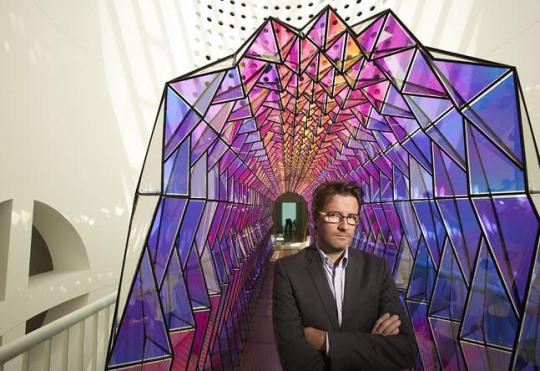

This weeks reading was a little hard for me to understand. I read over the reading about three times and still don’t understand all of it. I found this week very informative because I’ve never heard of the art “Installation.” I’m glad the reading this week gave some history about installation because if it didn’t I would be completely lost with it. One thing that I learned is that this art came into use recently and that’s probably why I haven’t heard a lot about it. I liked how in this section of reading it gave different types of installation and also it gave examples to match it so you can see the difference in each.
I found Do Ho Suh artwork very odd but at the same time interesting. I really loved looking at his outside sculpture that he made with the little people holding up a mini building it looked like. The other thing that I really liked was when he printed out all these faces of people and put them around a wall. I loved how the camera zoomed in with the pictures and slowly started to zoom out and you couldn’t even notice there were people on the wall.
I think the artist fits with this weeks reading but I’m not a hundred percent sure because I’m not for sure if I understand installation. By the teacher’s definition, installation doesn’t have an exact definition but it’s a sculpture that is connected to a place. So I think Do Ho Suh’s artwork that he made outside fits with installation.
The artist that I picked for this week is Olafur Eliasson. Eliasson was born on February 5, 1967 in Copenhagen, Denmark. Eliasson is an artist known for sculptures and large-scale installation art using the materials of light, water, and air temperature. The first picture is an artwork of Eliasson and I find this piece of art very interesting. It has many colors and it looks like the hallway is getting smaller the more you look into it. You can walk inside the hallway that is made of glass and it’s very shinny in my eyes. When I look at it, it reminds me of an aquarium because of the different color of blues and purples and the reflection off of the glass. The second picture is another of Eliasson’s artwork. This artwork is located in a park where everyone can view it. I find this artwork really cool because it’s made out of logs but it keeps getting deeper and deeper when you look inside it. I think this art would take forever because you need to have the right angles for each log so it stays where it needs to be. I think his idea for this art was trying to make you look at it like it’s an whirl pool going around in the circle but it’s made out of logs. Do Ho Suh and Eliasson are similar because they both do artwork dealing with installation but I think Do Ho Suh does more of it than Eliasson and puts more time into it. Eliasson does more colors with his artwork and does more with glass then Do Ho Suh does. Do Ho Suh really thinks outside the box and does a lot of things in broad colors. Overall this week was a little hard to understand I learned a lot from it.
3 notes
·
View notes
Text
Week 9
To me, installation art is confusing. Since there is no real definition of installation art, it is a very broad category. The best way to explain installation art is that it is a sculpture that is made in the place that it is suppose to be exhibited. It is not meant to be moved around. For example, Richard Serra built the steel wall in the place that it was going to be displayed. He did not build it in a studio and then move it to the park that it was going to be displayed it. Installation art can also be created in places such as a museum or gallery.
There are different types of installation art. There is interactive installations, which means the artist pulls in the audience to help present the piece of art work. There is also immersive virtual reality which means that technology and media is incorporated in the art work.
I found Do Ho Su very interesting. One story that he talked about that I found interesting was that he was saying he hadn’t had been sleeping very well lately. The last time he felt well was in Korea at his parents house. Since he obviously couldn’t sleep there, he designed a type of fabric and made the shape of his parents house out of it and designed it exactly how it looked. Do Ho Su made a public sculpture at a park so that falls under installation art, since it was built right where it was going to stay. I found the sculpture that he did in the park was very interesting. It was little people sculptures standing with their hands above their head holding the weight of these white blocks. I also thought that what he did with the year books he collects was very cool. It is a large wall and if you look close it is tiny pictures of the people in the year book. A lot of Do Ho Su’s artwork has to do with personal experiences. For example, his house made out of fabric is a replica of his parents house. Also, he made a piece of artwork that resembled the uniforms he use to have to wear in school.

This is Do Ho Su’s artwork of the uniforms from when he was in school.
For the relevant artist this week, I chose Olafur Eliasson. Olafur is a Danish-Icelandic artist who deals with sculptures and large installation art that incorporates light, water and temperature into it. Olafur was born on February 5, 1967. From looking at pictures of Olafur’s artwork, he likes to incorporate a lot of different color into his work. Maybe he is just a very happy person and likes all of the colors in his artwork. Maybe he thinks that all of the color makes his artwork more beautiful.

This is artwork done by Olafur Eliasson
0 notes
Text
Polly, I was also shocked that there were four different ways of sculpture. I did not know that. I was also amazed at how much money that artist made off of her horse sculptures. Something I kind of analyzed about Kara Walkers that maybe her family history, way down the line, dealt with slavery and that is why she is so touched from our history and wants to incorporate it in her artwork. She did put a lot of research and time into her sculpture and that just goes to show how much she cares about her work.
Week 8 - Sculpture
I never knew there were four plus ways of creating sculptures. I do have some knowledge of the medium of carving, as I have an uncle who is an avid carver. Each year he makes each one of his nieces and nephews a small piece of art. This past year I received this wooden “egg” – as I am not sure what to really call it.

Recently a high school friend visited Florence and took a picture of “David” for me, as that is my favorite piece of sculpture – hands down! He stated that is was absolutely beautiful to see in person and should be one everyone’s must see list.
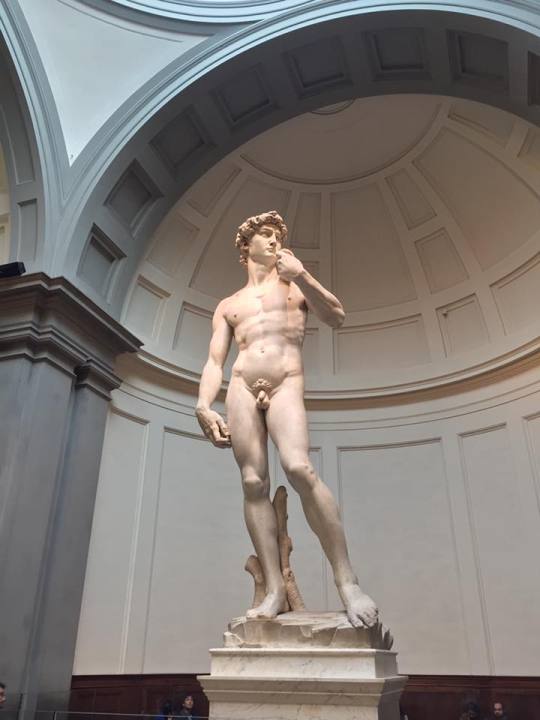
Regarding the horse assembly pieces made by Deborah Butterfield – I can’t believe that she creates these horses from discards and they sell for $240,000.00! Holy buckets, maybe I should start looking at all objects in a different light!
The article on preserving ephemeral materials was quite interesting and does pose a problem for both artists and museums alike. Zoe Leonard’s “Strange Fruit (for David)”, leaves a bad taste in my mouth. I’m not sure I would even want to see decaying pieces of fruit scattered around the floor, as the first thing that came to my mind were bugs, and the smell of the decaying fruit. I understand the importance of preserving pieces of art so that they may be seen for generations, but where in the heck do you draw the line? Museum curators should talk in depth with artist and do extensive research on all material(s) used before making that call; glad I don’t have to do that.
Kara Walker’s, “A Subtlety, or the Marvelous Sugar Baby,” was a huge project in every sense of the word. When I first read the description of the video I thought she and her team were making this sculpture from sugar, not huge blocks of polystyrene foam covered in sugar. I have to say this is the first time I have ever looked upon sphinx that is a black woman, very interesting to say the least. I get the feeling that as a black artist Kara was defining what happened during slavery and working in the sugar cane fields by placing this piece within the confines of the Domino Sugar Factory located in Brooklyn, NY. I also want to tie in that slavery was demolished (so-to-speak) just like the factory was at the end of her showing.
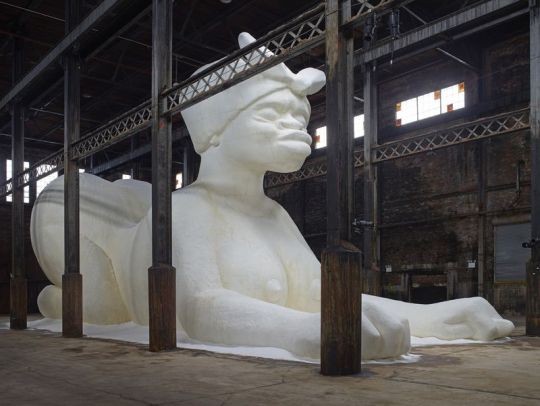
My relevant artist for this week is Tara Donovan, who is a contemporary American artist focused in sculptural and organic subject matter. Ms. Donovan likes to create large-scale installations and sculptures from items that we use every day. Items like tape, toothpick, paper cups, index cards, pencils, pins, paper, and my favorite buttons! Literally, thousands, upon thousands of buttons all glued together to make one simply amazing piece of sculpture entitled “Bluffs”. I thought it looked like a pretty piece of coral until I really started digging into the research. Tom Strini a writer at http://urbanmilwaukee.com is quoted as saying,
“Any one of them appears to be colorless and clear. But strange things happen as light travels through masses of them: It turns a dusky pink/mauve that I can’t recall seeing anywhere else. The varying densities within the piece make for an infinite scale of saturation of this beguiling color, which changes subtly with point of view.
And after scrolling thought photographs on her website, that is a correct statement. All the buttons are white/clear and depending on the amount of light is what color shows up. I really liked all of her pieces, but the “Bluffs” is what caught most of my attention.

4 notes
·
View notes
Text
Week 8
This week was about sculpture. I found this reading actually very interesting. There were a lot of little details that interested me in sculptor. There are four different original ways to make a sculpture. Carving with hard materials, sculpting soft materials, casting molten materials that will eventually harden and finding “things” and assembling them together to create a sculpture. I read in the book that before artists start making the actual sculpture, they will create it in a small sized model. Another thing that I found interesting in the book is Alice Aycock’s Tree of life sculpture. I found it interesting that she painted the whole thing white to symbolize the purity that is lacking in our world. I thought that was a very cool and unique explanation of why to do something. I also agree with her that this world is lacking a lot of purity. In the book, it talked a lot about carving with wood. I found it very interesting that the deity statues have survived since 1203. That’s over eight-hundred years old! Another type of sculpting that they talked about was wax. Which I think resembles Kara Walkers work but she uses polystyrene and coats it with sugar.
Kara Walker is an African American artist born in 1969 in California. Kara’s work resembles history. Even though the piece of art may not look like history, the meaning behind it has to deal with Sexuality, race, religion, etc. She thinks that it is very important to enter the future with knowledge of our history even though it may bring sadness. Coming from an African American family, maybe Kara deals with something like slavery that was in her family long ago. She may be affected from it in that way. Kara works with sugar, which I thought was interesting. She kind of talked about the history in slavery and how sugar pickers were done by slaves and underpaid workers. I think that may also play a role in her history and why she is so affected by it to incorporate her work into it. I thought it was very cool that Kara’s anticipation for her sculptures was for them to just sort of drip and melt away after everyone had seen them. I also thought it was very cool that she displayed her sculptures in an old sugar factory.
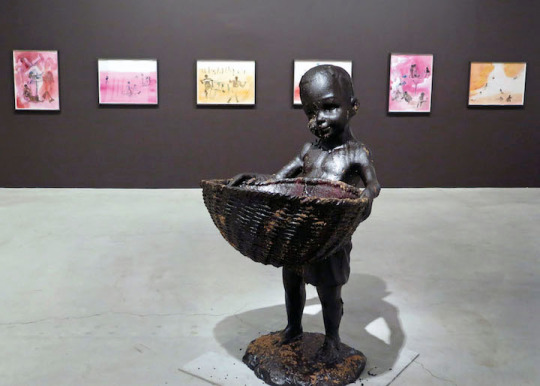
By: Petah Coyne
For my relevant artist, I chose Petah Coyne. Petah is an American sculpture and photographer. She uses organic material to make her sculptures, which I thought was cool. She is sixty-three years old and was born in Oklahoma. I was reading up on Petah and found some interesting, yet a little disturbing information on what she uses to create her sculptures. Ribbons, mud, dead fish, wax, sticks and more. Most of those things are normal except for the dead fish. The main meaning behind her sculptures are life and death, but there are some in betweens. Beauty, seduction, and vulnerability. When she decides to change her materials, it usually reflects on her travels. After I read that, I thought, maybe when she decides to use a certain material such as dead fish, maybe her last travel was somewhere like a lake where she saw a lot of that and it reflected back on her main meaning life and death.

By: Petah Coyne
2 notes
·
View notes
Text
Molly, I also agree with you when you say that cameras have come along way. I found it interesting to read that when cameras first came out, it took hours to develop the picture. Therefore, a lot of figures in the picture came out blurry since the people were walking while this was developing.
Something that I did not like about this weeks reading was all of the crucial pictures that were in it. I am not someone who enjoys seeing those kinds of things so I did not enjoy those pictures.
With this weeks video, I also agree that I wasn’t sure on what the producers was trying to tell us. I did not like any of the videos this week just because they were hard to understand and that frustrated me.
Week 7

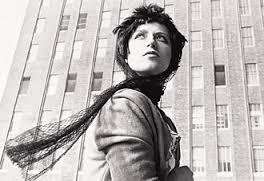
The relevant artist I selected this week is Cindy Sherman. Cindy is a film director and an American photographer. Cindy is well known for her conceptual portraits. Cindy was born on January 19th, 1954 in Glen Ridge, New Jersey and currently works in New York where she grew up. She started by getting into classes at the Buffalo State College getting into the basic studio courses drawing, painting, and photography. Starting in 1977 she had started to work on “Complete Untitled Film Stills” which was a series of 69 photographs. Beginning in the 1980’s Cindy used color fil and large prints that focused more on the lighting and facial expressions.
I really enjoyed reading through this chapter about photography and filmmaking. Photography is one thing I have always had an interest in. It was really neat to go through the chapter to look at all the different pictures. In the short film by Jullian Mayer I thought the message was a girl feeling good in her own skin. Not changing her body type to be the “hot beach babe” but being herself and who she is. Feeling comfortable in her own skin and feeling calm. I thought this video was calming with the ocean background noise. The short film by Jim Cummings he had seemed nervous about what was going on. It seemed like it was bothering him when he went and stood in front of the congregation. He was expressing his feelings for his mother who had just passed away. He shared stories although you could tell he wanted to go into full detail and when he started he would notice and start to stop. He had shared his feelings for his mother and I noticed it was very very hard for him to do that in front of the public. He had got up and danced and sang a song in front of the public. Every minute I noticed he had a different emotion. This showed me how people react different ways with difficult times. I have noticed sometimes when people go through a bad situation like this they may act different and not know what to do. The short film by Julia Pott was about characters having different emotions. The other not wanting to go rescue the other but the friend was able to get him up and give him motivation to go. He was searching all over for his brother Alex. Alex didn’t have much time he was begging for help. One thing I got from this video is say things you want people to remember you never know when its going to be someone’s last. We don’t know if we will get to see that person again so only say things we mean. This week it was neat to see people’s different photos along with the filmmaking. Everybody does things so different but it was very neat to see the films by the artist. I love the messages they try getting through to people. You guess what’s going on and you understand what is going through someone’s mind.
5 notes
·
View notes
Text
Week 7
Photography, as we all know has become a very popular resource for art. Taking a picture with a camera is considered art. As time moves on, we start to incorporate technology into our lives and especially into the art world. Art is no longer just a paint brush and paper or a pencil and paper. Photography first started out with the camera obscura. There was also the photogram which I found pretty neat since I had never really heard of or read anything on it. Photography first started out and then upgraded to color. But we still today use black and white in our photography. Something that I found really interesting in this chapter was that when color was wanting to be added to a certain picture, they often hand painted the color onto the black and white picture. For example, on page 282, figure 8.5. A back ground was also added to that photograph. The photographs that were incorporated in this chapter were really disturbing to me. I am not someone who likes graphic things so these pictures made me really uncomfortable. All of the photos in this weeks chapter really set the mood as gloomy and unpleasant. Another thing that I found cool in this weeks chapter was figure 8.18. The creator, Frank Noelker, takes photographs at places such as zoos and then makes changes via the computer.

(Frank Noelker)
For week seven, we did not have one art21 video, we has three different short clips to watch and honestly, they all confused me. I have come to conclusion, that for the hot beach babe, all of the computer mice symbolize an attraction to the beach babe. I think that they were tying to make us realize how much attention is paid to the beach babe. I did not like this video, all of the mouses kind of overwhelmed me.
Another one of our videos was by Jim Cummings. The scene of this video was at a funeral and I thought it was a little odd. I feel as though the producer was trying to make us feel like this video was all of grieving but I felt like their was a secret to it. It just seemed a little odd to me. When he started singing and dancing that was some sort of sign and then at the very end of the video when he was sitting with his little girl, she wouldn’t even look at her. It was like something bad had happened.
The last video “Belly”, that we had or watch was a very strange video. There were these weird creaters, almost like they were made up of different body parts from certain animals, and then a weird creature. The people went through this creatures skin and then the parts would grow back. Maybe this video was trying to symbolize to stick with the ones that you are close with.
For my relevant artist this week, I chose Sally Mann. It says that she works a lot with black and white photography. She started taking pictures of her young children but then moved on to taking photographs of landscape. Maybe, as a new mother and artist, her main focus was capturing the moments with her young children to always have the memories. As they grew older, maybe they did not want their photographs taken so she moved on to something else that she loved and that was landscaping.

(Sally Mann)
0 notes